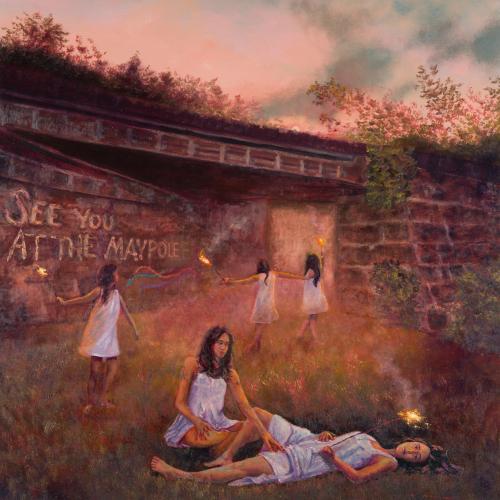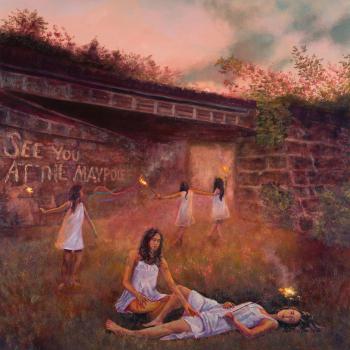
See You At The Maypole Half Waif
Album info
Album-Release:
2024
HRA-Release:
04.10.2024
Album including Album cover
- 1 Fog Winter Balsam Jade 03:46
- 2 Collect Color 03:23
- 3 I-90 04:23
- 4 Figurine 04:11
- 5 Heartwood 02:45
- 6 Big Dipper 04:07
- 7 Shirtsleeves 01:13
- 8 Sunset Hunting 03:43
- 9 Dust 03:41
- 10 Slow Music 03:51
- 11 Ephemeral Being 02:51
- 12 Violetlight 02:26
- 13 Velvet Coil 02:27
- 14 The Museum 03:41
- 15 King of Tides 03:57
- 16 Mother Tongue 03:03
- 17 March Grass 06:14
Info for See You At The Maypole
In the deep Upstate New York winter of 2022, trees bare and taunting, Nandi Rose found herself searching for an apricitic clarity. She has always found the season difficult; its ruthless theft of birdsong and flora, heavy clouds low and smothering what little light remains. But the cacophonous silence of that winter was particularly brutal. It should have been stirred by the growth of life, a promise of a new chapter, a bright dawn, as Rose learned she was pregnant with her first child. That promise was broken in early December, when stillness took over the ultrasound screen; slow-motion mouths told her the life inside her had ended. Like a snapped branch weighed down by leaden frost, Rose lost a part of her future she thought would blossom.
Baldwin tells us we must say yes to life, to “embrace it wherever it is found – and it is found in terrible places – nevertheless, there it is.” This is the guiding force of See You At The Maypole, the sixth full-length album in Half Waif’s prolific catalog. If we look for color in the midst of our own personal winters, the brightness will soon begin to bounce off the snow. This gathering of resilience and clutching of chiaroscuro––celebrating both light and dark––guides us on a journey towards acceptance and surrender. Rose had to figure out how to love her life, even if it didn’t look like what she wanted it to.
See You At The Maypole was originally intended as a departure from the darker works of Half Waif. Whereas 2021’s Mythopoetics dealt with familial traumas and the patterns we carry with us, Rose––armed with the anticipation of planning her own family––envisioned a new collection of soft and joyous odes to motherhood, and to new beginnings. That writing sparked in the summer of 2021 at a solo retreat in the Catskills, as melodies formed in a small cabin overlooking a luscious and rain-rippled pond. A month later, Rose found out she was pregnant and anticipated nine months of writing through a new, maternal lens, speckled with the verdure of certainty. But when that soundless morning arrived in December, See You At The Maypole took on a new life. One that would seize the uncomfortable reigns of uncertainty.
The treatment of a missed miscarriage, as with an at-home abortion, is most effective with the use of two pills: mifepristone and misoprostol. Rose, however, was only prescribed the latter, likely due to FDA regulations on the former. Over the course of the next four months, her body did not recover as it should have. It wasn’t until the spring that she learned she had retained pregnancy tissue and needed an additional procedure, finally allowing her to move forward. “I was literally carrying death inside me,” she explains, “and then my body was frozen.” In that same time, Rose’s beloved mother-in-law was diagnosed with aggressive pancreatic cancer; it felt like the universe was playing an endless, cruel joke. And so, Rose wrote to save herself. Before the sunrise, she wrote in the quiet corner of the would-be nursery while her husband slept across the hall. These were lullabies for no one, whispers dissipating into the fog.
While the seclusion of grief feels infinite, Rose brought the songs to her trusted friend and longtime collaborator of the past decade, Zubin Hensler. The pair worked away from others for Mythopoetics, carefully crafting each note and flourish themselves but something else was needed for See You At The Maypole. Rose was learning to loosen her grip on perfection, to splatter the canvas or leave the dropped stitch, and know that it will be beautiful anyway. “How can I take the heaviest material of my life and make it feel like air?” she asked. Live takes, whispered early-morning vocals and distorted phone recordings were all kept. It became a children’s coloring book, broken crayons smudged across the lines.
In The Wild Edge of Sorrow: The Sacred Work of Grief by Francis Weller, the author highlights the importance of ritual spaces, and how many communities tend to gather in these spaces when someone has lost a loved one. Though the stem of many of these songs were written in isolation, Rose’s lullabies would soon bloom into a collective calling for anyone experiencing their own personal winter. See You At The Maypole is a room for wailing, not just for catharsis but for connection. Like lung-bursting sing-a-longs alone in the car, notes leaving the open window to be caught by another.
“This wasn’t just my story, I wanted to say. It was every story of loss—the loss of a life, the loss of a dream, the loss of trust and hope and faith. A story of finding a way back again,” Rose explains. “My own avenue back to the land of the living was through my relationships with people and with the natural world. It only seemed right that these songs would invite those people in to build the very heart of the sound.” To that end, Hensler and Rose welcomed a wealth of players and friends into the world of the record: Jason Burger and Zack Levine on drums and percussion; Josh Marre (Blue Ranger) on guitar; Hannah Epperson and Elena Moon Park on violin; Kristina Teuschler on clarinet; Willem de Koch on trombone; Rebecca El-Saleh on harp; and Spencer Zahn on upright bass. Andrew Sarlo (Big Thief, Bon Iver) lent his deft mixing skills to many of the tracks, including lead single ‘Figurine.’
New York City-based choir Khorikos adorns several songs, most notably on opener ‘Fog Winter Balsam Jade’ urging a mantra of collective howling. Naming those stomach-prodding reminders of grief but still recognizing their beauty: cutting an apple in the kitchen; watching a bird take flight from the back yard; a morning glory climbing up the corner of the house (‘Collect Color’); a sunset in the rearview mirror (‘I-90’); fog, winter, balsam and jade. The natural world has often been a cradle to Rose––a gentle sway of serenity––but it’s on See You At The Maypole that she had to look to its tougher lessons, and embark on a metamorphosis of her own. “Let me be oak,” she utters on ‘Heartwood’. “I embrace in all directions.”
Hensler and Rose recorded some––but not all––at Hensler’s Brooklyn studio, departing the comfort of those reassuring walls and stepping into the constellations of Chatham, NY, Kingston, NY, the St. Anthony of Padua Church in Manhattan, and notably, Imogen Heap’s The Hideaway studio in England. Hidden in the heart of a green conservation area, The Hideaway provided a foundation for moments on ‘Fog Winter Balsam Jade’; the urgent, percussive swells of ‘Ephemeral Being’; the glittering statement of ‘Heartwood’ and ‘The Museum’ –– a languid, uneasy look at bringing life into a crumbling world. There is no shadow without light, and as the strings soar, Rose desperately grasps at the responsibility of motherhood. Sustained, ghostly vocals fill the outro, wrestling with the blessing and insecurity of new parenthood.
Dynamic arrangements adorn See You At The Maypole, but there are also moments of simplicity. ‘Figurine,’ a tender ballad written in January 2022, mimics the immobility of pain, but the perseverance of trying to move past it. Rose’s quiet lament of “I love you when it’s snowing, I love you when it’s warm” opens the song, pointing to the seasons of grief, as well as the glimmer of change and growth. “Not everyone will go through a miscarriage, but this is a song about how to continue on after losing something precious, how to find the light on your face again,” Rose says. “Head up, it’s gonna get so much better you’ll see,” it urges, a chin-up, jewelry box figurine, continuing its dance despite it all.
See You At The Maypole is a recognition of personal sadness, and a call to ecstatic togetherness. It’s gathering the colors of our spirit, in all its shades, and making something intricate and remarkable. The ceremonial folk dance performed around a maypole is filled with fauna and flora, with ribbons woven into complex braids incapable of unraveling; these dances are survivals of ancient ritual, honoring the living trees, and the return of Spring and fertility. These patterns––this dance––cannot be completed alone, and so, Half Waif welcomes others to join her, a collective of bleeding color. “We are so much stronger for the colorful experiences we go through,” she says. “That's where we find our humanity and find each other.”
Half Waif
Nandi Rose Plunkett aka Half Wai
is the sound of a creative mind constantly searching for balance. The music created by New York-based artist Nandi Rose is a painfully sweet push and pull, walking the line between light and dark, analog and digital, and themes of both solitude and community. Her sound comes in flashes of Kate Bush and James Blake, marrying a more traditional songwriting sensibility with playful sonic exploration and fearlessness.
Nandi Rose Plunkett aka Half Waif has released a video for the lead single from her upcoming album Lavender, out on April 27th via Cascine. Its a brooding yet beautiful piece of synth-pop, the chords weigh heavy on the track, giving it that feeling of almost drowning at some points, while over the top Plunketts rich vocal, sometimes shrouded in harmony, sometimes clear, pulls at your collective heart strings. Of the track, she says its “about the evolution of the self in a relationship: the maintenance of autonomy in the midst of a process of coupling, ageing, and decay.”
As a concept its illustrated in the Celina Carney-directed video by “showing two states of being that we experience in relationships: together and alone,” Plunkett explains. “The two boxers stand off as if to fight but then dissolve into a series of movements that depict both a struggle and a communion. They push off each other in one moment and guide each other the next. Meanwhile, alone inside a clear box, the solitary character explores confined movement and confronts boundaries that are invisible yet impermeable. Throughout the video, the three ‘Diamond Head’ dancers act as a kind of Greek Chorus, mischievously threading between the two states of being, operating as the only connection between the isolated islands. Together, these entities explore the ways we attempt to escape from ourselves by hiding inside others – and what we hide from others by keeping it for ourselves.”
This album contains no booklet.







